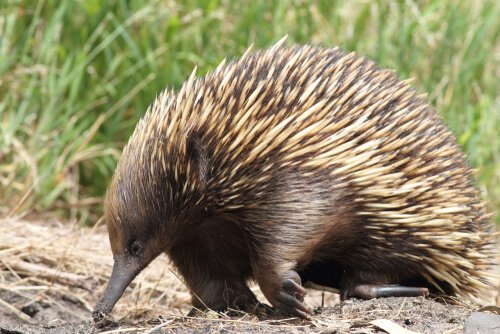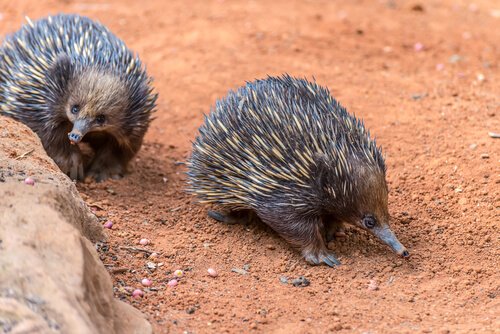Behavior of the thorny anteater
The spiny anteater, also known as an echidna, makes up five of the six species of monotreme mammals. These are primitive mammals that lay eggs like reptiles , but have hair and nurse their young.
This species of spiny anteater can be found in Australia, New Guinea and Tasmania . The sixth monotreme species is the platypus, which does not resemble the echidna, except in the particularity of laying eggs.
Characteristics of the thorny anteater
Monotremes like the echidna lay eggs and have an internal bony structure for the extremities that emerge from the sides of your body. In this sense, they are quite similar to reptiles, as well as birds.
They have a single chamber, known as the cloaca, in which the intestine, bladder and reproductive organs are emptied. Also, monotremes have hair, produce milk and are warm blooded . Your ability to maintain your constant body temperature is not always very successful. Because of this, they often hibernate for long periods during the winter.
A small organ located on the hind legs of the male gave the thorny anteater its echidna name , which means adder. This is because it is 'connected' to a poisonous gland. However, the fluid that emanates there is not really very poisonous.

It is unlikely that the echidna will use that poison as a weapon. In general, these animals will try to escape by digging a hole when they are in danger . They have powerful claws that allow them to dig and 'fly' the earth to the side to hide quickly.
Echidna morphology
The thorny anteater looks a lot like porcupine and often confused with this animal . This is because it has numerous yellow spines that cover its body with brown fur. However, the spines of the echidna do not have spikes that get caught in the skin.
An adult echidna can reach about 76 centimeters in length approximately , although it can often be see it curled into an impenetrable ball and look smaller. It has a thin, hairless snout, with a pair of nostrils at the end.
The small mouth is located at the bottom of the snout and opens just enough to that the long, sticky tongue emerges. This can measure about 30 centimeters and, with it, drags its food, which usually consists of ants, termites and other insects.
Echidnas have no teeth . Instead, they cut the hard bodies of their prey by striking them against the roof of their mouth and crushing them with their spiny tongue.

They have a bag like the marsupials, but, unlike these, it only develops in the breeding season . The female lays a semi-hard shell egg that she places in the bag. In a short time that egg becomes a partially developed baby.
Behavior of the thorny anteater
Much about the behavior of the echidna is a mystery. They are very difficult to study, the researchers say, because of their solitary behavior. They are not easy to locate, they are very quiet and often travel long distances . His passion for travel is one of the reasons why they are not fit to live in captivity.
Echidnas do not have routines, and they can be active both day and night regardless of the weather.They do not socialize and are not known to fight each other.
They tend to ignore other creatures of the same species, except when it's time to mate . During the Australian winter up to a dozen males form lines, and creep slowly and silently behind a female who emits pheromones.
This parade can persist up to a month, while some males leave and they incorporate others . Finally, the receptive female ends up clinging to a tree trunk with her forelimbs. The males dig a circular ditch around the tree and compete for the honors of mating.
There is no aggression, because the males simply push each other , head to head. As each one moves away, he leaves. The winner lies sideways in the trench, partially below the female, and they mate slowly.


